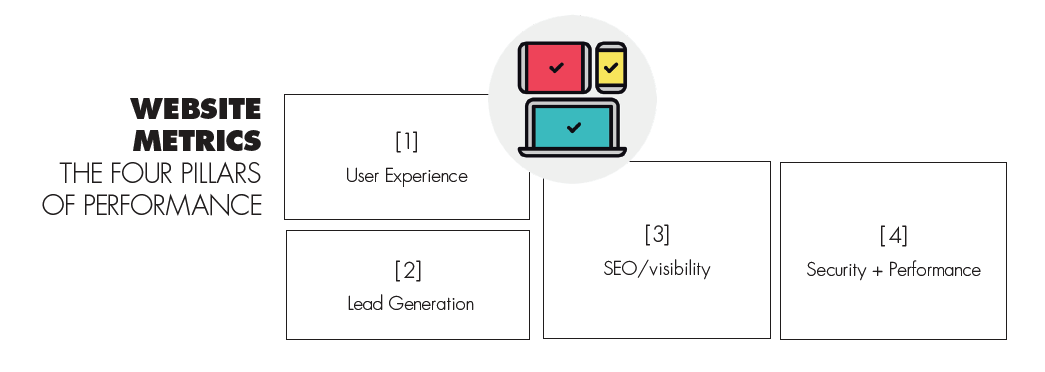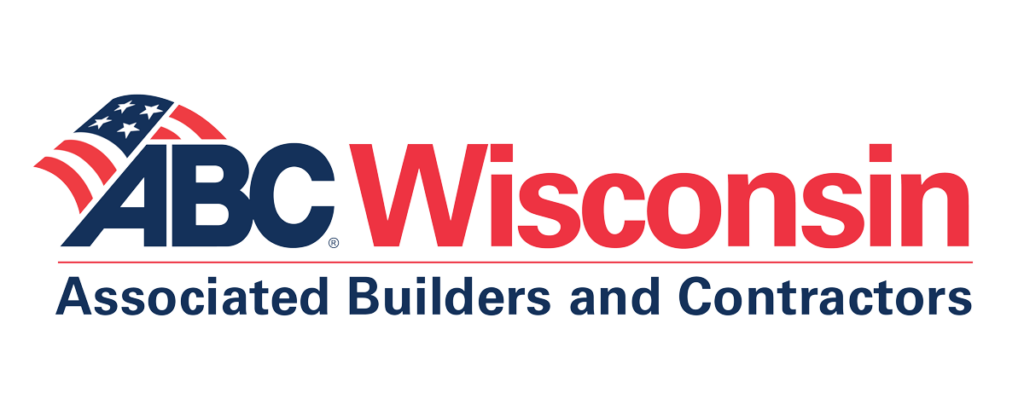You are working hard every day in your business. Many contractors don’t think of their website as more than an online brochure. What would your business look like if your website was actively working for you? Bringing in new business, attracting new employees, setting your company up as the go-to contractor in your area – these are just a few things that a website should be doing for your construction business.
A website is really the foundation for your business online. Everything leads back to your website: your social media accounts, your online ads, your email, search engine optimization (SEO), Google and all of your traditional offline advertising. For this reason, you need to make sure your website is a reflection of your business and presenting an image you want to be proud of.
There are four pillars that help us evaluate a website performance: (1) user experience, (2) lead generation, (3) SEO/visibility, and (4) security & performance. Let’s break these down a bit!

User Experience
When researching for a new contractor, most people will jump on their phone or computer to search for a local company that meets their needs. If you don’t have a website or you have a website that doesn’t accurately define your business, then you are missing out on valuable leads or sending the wrong message.
Your website should have a professional design and reflect the quality of your work. Does your website reflect the types of jobs your company wants to be working on? So often I see contractor websites with confusing messaging or showcasing projects that aren’t really their ideal projects. You don’t have to show everything you do on your website. It’s important to attract more of the work that you really WANT to be doing, especially when you are busy. If your site doesn’t relay what services you offer or your site doesn’t look like it is up to the times, then that will turn away possible leads. You want your website to draw ideal customers in.
In 2020, a mobile-friendly website is a necessity! 77% of Americans now use smart-phones. 52.2% of website traffic is generated from mobile phones (Source: WebFX) and 61% of mobile searchers are more likely to contact a local business if they have a mobile-friendly site. If your website is not mobile-friendly you are missing out on half the traffic you could be generating. A mobile friendly website has:
1. Images and text sized for mobile devices
2. Click-to-call buttons and forms that make it easy to contact
3. Menus that are easy for website visitors to use on their mobile devices
Lead Generation
You want to make it easy for your customers to contact you. Only including a phone number isn’t enough. While people used to always pick up their phone and make a phone call that’s not the case anymore, especially if you are targeting millennials as customers or employees. People are busy and don’t have the time to always make phone calls. Your customers are also people who grew up in the digital age, so you need to adapt your website for the current times.
Your phone number should be clearly listed at the top of your site. Don’t make people search around to find it. If they need to do that, there’s a good chance they will leave and find someone else. Include web forms on your site. This can be anything from automatically scheduling an appointment to filling out a job application. Offer a live chat! When customers can live chat you with questions or requests, you are putting yourself one step ahead of your competition. Offering that customer service before they even become a customer leaves a great impression. The last thing you can do is offer an instant quote. This is quick and easy for your customers and you. You can offer them a quote and then they can make their appointment right online. Before someone contacts you, they are looking at your website. You want to make sure that your messaging on your site is clear and to the point. Your messaging should reflect your customer’s needs and solve their problems. It is not about you. If this is clear on your website, then leads are more likely to turn into customers. Testimonials also help. When someone is checking out your website and sees testimonials throughout, it solidifies your expertise and creates a positive image of your brand in the customer’s mind. Some 93% of consumers say online reviews impact their purchasing decisions. Asking for testimonials after each job keeps the testimonials fresh and your list of testimonials grows.
Visibility & SEO
There are numerous ways you can add visibility to your website and increase SEO. One of the more important things to consider is the quality of your photos. You can take your own photos or find a beginner to take the photos for an inexpensive price, but your photos will reflect that. Hire a professional to take your photos so your photos accurately reflect the quality of your work.
Integrating your Instagram feed or Facebook gallery into your site gives your customers a more extensive view of the quality of the work you do. It makes it seamless on your end as well; the photos automatically update on your website after you update your social feed.
Showcasing the associations you are part of, awards you have received and vendors you partner with shows your extensive work and dedication to your craft. These partners and associations typically list you as well, so that extends your visibility beyond your own website. Keeping your website up to date with fresh content, new testimonials and images keeps it fresh and keeps Google happy. The more content you provide, the higher your results will be on Google and will continue to grow your visibility.
Security and Performance
Installing Google Analytics on your website should be one of the first things you do. With Google Analytics; you can track your online marketing efforts, the content you create, the user experience on your website and the actual functionality of your site. Tracking this information gives you the ability to see improvements needed on your website itself and with your marketing strategies. The more improvements you can make, the better the customer experience on your site.
Making sure your website is secure will give you peace of mind. You should start by con-firming you have a basic SSL certificate. If you don’t, then your website host should provide that to you at no charge. Updates are also an important aspect of keeping your site secure. Keeping your website up to date and scanning your website for threats helps keep your site secure and prevents costly issues that happen when websites are left vulnerable. If your host didn’t automatically provide you with a security scan feature, you should have the ability to purchase that as an add on. Without a security strategy, businesses risk the spread and escalation of malware, attacks on other websites and networks.
The other thing you want to do is to back-up your website. This should be done on a regular basis. We recommend at least monthly, if not more. A backup of your website may be a feature your host provider offers. If it isn’t it should be available as an add on to your package.
The four pillars build upon each other to create a website that works for both you and your customers. You work hard. Your website should, too!
Catherine Wilson is Key Marketing Strategist with Home Pro Digital. She can be reached at Catherine@evivamedia.com or 262-720-3939.












